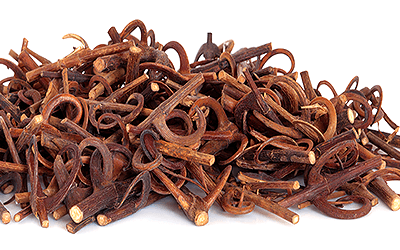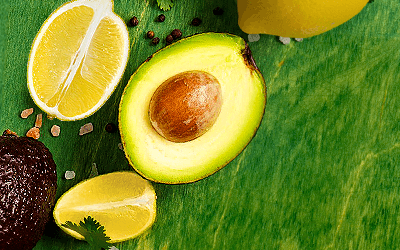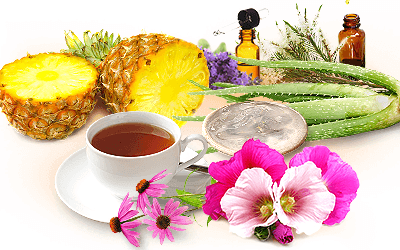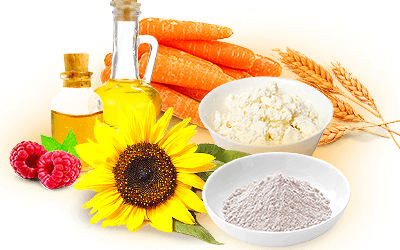The normal human body temperature ranges from 97 to 99°F (36 to 37°C).
Fever is defined as a temporary increase in the body's temperature above normal, typically 100.4°F (38°C) and higher. It is the first response of the immune system to infection or injury. It can also be caused by inflammatory diseases such as rheumatoid arthritis, and external factors like heat exhaustion.
Common symptoms associated with fever include chills, sweating, headaches, muscle aches, fatigue, lack of appetite, irritability, and dehydration, all of which can be easily treated at home; however, high temperatures accompanied by seizures, mental confusion, and difficulty breathing require immediate medical attention.
Herbs to Reduce Fever Naturally
While antipyretics, like paracetamol or ibuprofen, are usually the most popular over-the-counter medication to reduce fever, herbal teas have been traditionally prescribed to help lower body temperature and prevent dehydration. There are many plants with anti-inflammatory, antipyretic, and diaphoretic properties that can help reduce body temperature. Discover how to break a fever naturally and have a quick recovery with these amazing herbs!
Did You Know?Salicin is transformed by the liver into salicylic acid, the anti-inflammatory compound in aspirin.
Aspen
Salicin is transformed by the liver into salicylic acid, the anti-inflammatory compound in aspirin.
The most important compound in aspen is salicin, a naturally occurring compound that is capable of reducing the inflammatory response to damage and infection, including fever.1 An aspen bark decoction can be taken to relieve joint pain and fever.
Cat's Claw
This Amazonian herb has become quite popular for treating inflammatory processes, mainly joint pain; however, it can also reduce fever and the body aches associated with it. Cat's claw decoctions and infusions have been shown to have strong antiviral properties that help treat the symptoms of dengue fever and other viral diseases.2
Feverfew
As its name suggests, feverfew has been traditionally used to break fevers and alleviate headaches associated with inflammatory processes. It has been shown that two active compounds of feverfew, parthenolide and Bay 11-7082, successfully inhibit pro-inflammatory cytokines that cause headaches and fever.3 Feverfew is also among the best herbs for migraines. This medicinal herb is widely available in nature as well as in medicinal forms, such as pills, liquid extract, and teabags.
Lemon Verbena
Lemon verbena has a long history of use in folk medicine, mainly for treating cold symptoms. Phenolic compounds are responsible for the anti-inflammatory, antibacterial, and antipyretic properties of the herb, which stimulate sweating to break fever and congestion.4 Lemon verbena is commonly consumed as an infusion obtained from steeping the leaves in hot water, but it is also available in practical teabags and capsules.
Marigold
The analgesic and anti-inflammatory properties of marigold can lower high temperatures and pain. This medicinal herb is widespread all over the world, and it is popularly grown in gardens as an ornamental plant. Marigold is considered one of the top antiviral herbs due to its natural antipyretic compounds, which can help reduce fever naturally.5
Raspberry
While raspberry fruits are highly popular for their sweet, slightly tart flavor, raspberry shoots and leaves have been used as an herbal remedy for centuries, mostly for treating the common cold, fever, and flu-like infections. The naturally abundance tannins and flavonoids are the likely source of these medicinal properties.6 So, if you're looking for ways to lower fever naturally, a raspberry leaf tea can be the answer.
When body temperature rises abnormally high, it is usually the result of an infection, either viral or bacterial. While over-the-counter medications are widely available, they can take a toll on liver function and cause an upset stomach. Antipyretic herbs have been used for centuries to reduce fever and pain, and they are generally safe to consume. Sipping a warm herbal tea can help you feel better in no time!
Sources
- Harvard Medical School, Fever in adults: When to worry, 2023
- Medlineplus, Fever, n.d
- National Library of Medicine, Physiology, Fever
- Pharmaceutical Biology, Brazilian medicinal plants with corroborated anti-inflammatory activities: a review, 2018
- Surgical Neurology International, Natural anti-inflammatory agents for pain relief, 2010
- University of Nebraska Omaha, Fevers 101: How to Treat Them and When to Get Help, n.d.
Footnotes
- Plants (Basel). (2022). Microwave-Assisted Water Extraction of Aspen (Populus tremula) and Pine (Pinus sylvestris L.) Barks as a Tool for Their Valorization. Retrieved February 19, 2024, from: https://www.ncbi.nlm.nih.gov/pmc/articles/PMC9228133/
- International Immunopharmacology. (2008). Immunomodulating and antiviral activities of Uncaria tomentosa on human monocytes infected with Dengue Virus-2. Retrieved February 20, 2024, from: https://pubmed.ncbi.nlm.nih.gov/18279801/
- Journal of Biological Chemistry. (2010). Anti-inflammatory Compounds Parthenolide and Bay 11-7082 Are Direct Inhibitors of the Inflammasome. Retrieved February 20, 2024, from: https://www.jbc.org/article/S0021-9258(19)55035-9/fulltext
- Foods. (2021). Chemometric Profiling and Bioactivity of Verbena (Aloysia citrodora) Methanolic Extract from Four Localities in Tunisia. Retrieved February 21, 2024, from: https://www.ncbi.nlm.nih.gov/pmc/articles/PMC8700817/
- Phytotherapy Research. (2008). Studies on the antioxidant and analgesic activities of Aztec marigold (Tagetes erecta) flowers. Retrieved February 21, 2024, from: https://pubmed.ncbi.nlm.nih.gov/18814202/
- BCM COmplementary Medicine and Therapies. (2014). Chemical composition and biological activity of Rubus idaeus shoots - a traditional herbal remedy of Eastern Europe. Retrieved February 21, 2024, from: https://www.ncbi.nlm.nih.gov/pmc/articles/PMC4295307/









